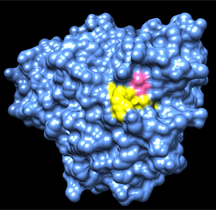Findings Illuminate How Mystery MS Drug Works
A study by scientists at The Scripps Research Institute (TSRI) has helped to de-mystify the molecular workings of the multiple sclerosis (MS) drug Tecfidera®. The drug is the most widely prescribed pill-based therapy for MS, but its biological mechanism remains mysterious.
Using a new TSRI technology that can quickly reveal a drug’s protein targets, the scientists showed that Tecfidera® interacts with multiple T cell proteins, in some cases inhibiting their activity, and helping to suppress the T cell activation that is a key feature of MS flare-ups.
“This new technology has given us insights into the therapeutic modulation of the immune system that we could not have obtained with standard approaches,” said co-senior author John R. Teijaro, an assistant professor at TSRI.
The study was reported recently in Science Signaling.
Treatment for an Autoimmune Disease
MS is an autoimmune disease of the brain featuring damage to nerve fibers and producing a range of symptoms, including tingling in the extremities, muscle weakness, muscle spasms, visual problems and mood instability. About 400,000 people in the United States and about 2.5 million worldwide have MS, mostly in a form with intermittent flare-ups of symptoms—which can start to worsen inexorably.
Two large clinical trials published in 2012 found that Tecfidera® is almost twice as effective as an older standard MS drug at reducing the rate of flare-ups. It also appears to slow the disease’s progression. But how the drug works has never been clear.
Despite its recent (2013) US Food and Drug Administration approval for MS, the drug is neither new nor high-tech. It is a relatively simple organic compound, dimethyl fumarate (DMF), that has been in the biomedical literature for decades. It was once used in Europe to prevent mold growth in sofas during storage and shipping, although the European Union banned it from consumer products in 2009 after it was linked to severe allergic skin reactions. It has proved more useful as a pharmaceutical: since the 1990s it has been an effective treatment—as the main ingredient in the drug Fumaderm®—for the autoimmune skin disease psoriasis. Success against psoriasis led to its investigation as a potential MS drug.
Until recently, the leading theory was that DMF works against MS primarily by unleashing the activity of a protein called Nrf2, which helps protect the brain from autoimmune damage by marshaling a powerful anti-oxidant response and which may also reduce immune system activation. Studies published in the past year have suggested, however, that DMF works principally by reducing immune system activity and does so independently of Nrf2. In recent years, there have also have been several reports among patients taking Fumaderm® or Tecfidera® of a potentially fatal viral brain infection called progressive multifocal leukoencephalopathy, which normally occurs only in people whose immune systems have been seriously weakened.
Mapping the Pathways
To get a clearer picture of the pathways through which DMF works against MS, co-senior author Benjamin F. Cravatt, chair of the Department of Chemical Physiology at TSRI, and first author Megan M. Blewett, a PhD candidate at TSRI, teamed up with Teijaro to show that DMF inhibits the activation of human T cells. To identify the proteins targeted by DMF in these cells, the team then used a new research tool developed in the Cravatt laboratory. Described in a paper in Nature Methods in 2014, the tool enables researchers to globally map targets of a given drug compound in a complex sample of proteins, even the many thousands of proteins contained in live cells in a lab dish. The process specifically reveals where a compound makes very strong “covalent” bonds with cysteine amino acids on the proteins, cysteines being common targets of reactive drug molecules such as DMF.
In this way, the team found that within activated human T cells, DMF reacts with about 50 different cysteines, in about as many proteins. The affected proteins include enzymes and regulators of gene activity. “Several are known as members of the NF-κB signaling pathway, a critical pathway for T cell activation,” said Blewett.
The team confirmed that DMF blocks the activation of T cells, and that it does so, at least in part, by targeting two cysteine residues on the immune cell signaling enzyme PKCθ, thereby preventing PKCθ from associating with CD28, another protein needed for proper T cell activation.
Even in T cells lacking PKCθ, DMF was able to reduce signs of activation further. That and other evidence strongly suggest that DMF’s full immune-damping impact results from its interactions with multiple proteins. “People often assume that a given drug works by hitting one target, but DMF likely produces its immunomodulatory effects by hitting multiple targets,” Blewett said.
“This study shows the value of applying large-scale chemical profiling methods to primary human cells to gain insights into the mechanism of action of an important immunomodulatory drug,” Cravatt said.
Cravatt, Teijaro, Blewett and their colleagues are now using the “target map” generated by this study to pursue the development of other compounds that might modulate immune activity in a more precise manner—hitting only the most important cysteine targets, for example on PKCθ—with fewer side-effects. “We’re interested ultimately in making more selective, site-specific drugs, both to reduce immune activity and to boost it,” said Teijaro.
He credits the strong multidisciplinary environment of TSRI for the successful collaboration. “It really shows the strength of this place that chemical biologists can work with an immunologist like me to produce such valuable insights into drug therapy and the immune response,” Teijaro said.
The other co-authors of the study, “Chemical proteomic map of dimethyl fumarate–sensitive cysteines in primary human T cells,” were Jiji Xie and Amnon Altman of the La Jolla Institute for Allergy and Immunology, and Balyn W. Zaro and Keriann M. Backus of TSRI.
Funding was provided by the National Institutes of Health (grants CA087660, GM108208), the Donald E. and Delia B. Baxter Foundation, LEO Pharma, the National Science Foundation Graduate Research Fellowship Program and the Hertz Foundation.
Send comments to: press[at]scripps.edu














